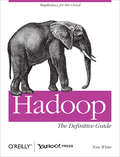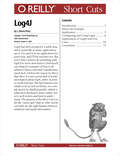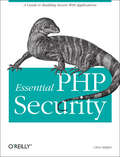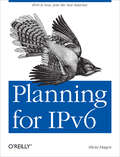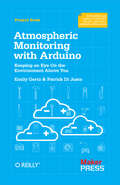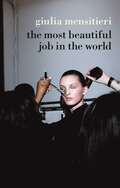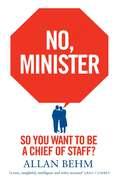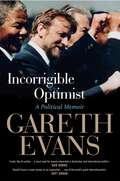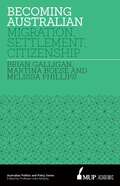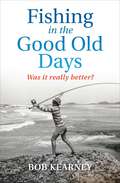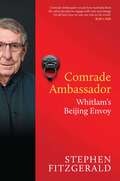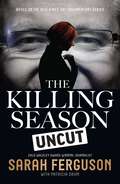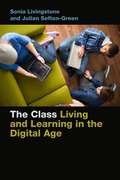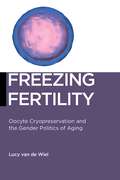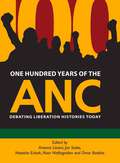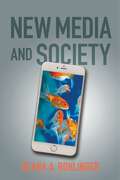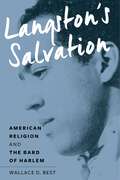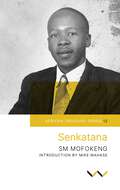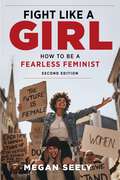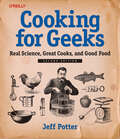- Table View
- List View
Hadoop: The Definitive Guide
by Tom WhiteHadoop: The Definitive Guide helps you harness the power of your data. Ideal for processing large datasets, the Apache Hadoop framework is an open source implementation of the MapReduce algorithm on which Google built its empire. This comprehensive resource demonstrates how to use Hadoop to build reliable, scalable, distributed systems: programmers will find details for analyzing large datasets, and administrators will learn how to set up and run Hadoop clusters.Complete with case studies that illustrate how Hadoop solves specific problems, this book helps you:Use the Hadoop Distributed File System (HDFS) for storing large datasets, and run distributed computations over those datasets using MapReduceBecome familiar with Hadoop's data and I/O building blocks for compression, data integrity, serialization, and persistenceDiscover common pitfalls and advanced features for writing real-world MapReduce programsDesign, build, and administer a dedicated Hadoop cluster, or run Hadoop in the cloudUse Pig, a high-level query language for large-scale data processingTake advantage of HBase, Hadoop's database for structured and semi-structured dataLearn ZooKeeper, a toolkit of coordination primitives for building distributed systemsIf you have lots of data -- whether it's gigabytes or petabytes -- Hadoop is the perfect solution. Hadoop: The Definitive Guide is the most thorough book available on the subject."Now you have the opportunity to learn about Hadoop from a master-not only of the technology, but also of common sense and plain talk."-- Doug Cutting, Hadoop Founder, Yahoo!
Log4J
by J. Steven PerryLog4j has been around for a while now, and it seems like so many applications use it. I've used it in my applications for years now, and I'll bet you have too. But every time I need to do something with log4j I've never done before I find myself searching for examples of how to do whatever that is, and I don't usually have much luck. I believe the reason for this is that there is a not a great deal of useful information about log4j, either in print or on the Internet. The information is too simple to be of real-world use, too complicated to be distilled quickly (which is what most developers want) and/or not very well written and hard to understand. The purpose of this Short Cut is to hit the "sweet spot" that no other works currently do: the right balance between simplicity and useful information.The code for this Short Cut is available at the code example repository.
Code Simplicity: The Fundamentals of Software
by Max Kanat-AlexanderGood software design is simple and easy to understand. Unfortunately, the average computer program today is so complex that no one could possibly comprehend how all the code works. This concise guide helps you understand the fundamentals of good design through scientific laws—principles you can apply to any programming language or project from here to eternity.Whether you’re a junior programmer, senior software engineer, or non-technical manager, you’ll learn how to create a sound plan for your software project, and make better decisions about the pattern and structure of your system.Discover why good software design has become the missing scienceUnderstand the ultimate purpose of software and the goals of good designDetermine the value of your design now and in the futureExamine real-world examples that demonstrate how a system changes over timeCreate designs that allow for the most change in the environment with the least change in the softwareMake easier changes in the future by keeping your code simpler nowGain better knowledge of your software’s behavior with more accurate tests
Essential PHP Security: A Guide to Building Secure Web Applications
by Chris ShiflettBeing highly flexible in building dynamic, database-driven web applications makes the PHP programming language one of the most popular web development tools in use today. It also works beautifully with other open source tools, such as the MySQL database and the Apache web server. However, as more web sites are developed in PHP, they become targets for malicious attackers, and developers need to prepare for the attacks.Security is an issue that demands attention, given the growing frequency of attacks on web sites. Essential PHP Security explains the most common types of attacks and how to write code that isn't susceptible to them. By examining specific attacks and the techniques used to protect against them, you will have a deeper understanding and appreciation of the safeguards you are about to learn in this book.In the much-needed (and highly-requested) Essential PHP Security, each chapter covers an aspect of a web application (such as form processing, database programming, session management, and authentication). Chapters describe potential attacks with examples and then explain techniques to help you prevent those attacks.Topics covered include:Preventing cross-site scripting (XSS) vulnerabilitiesProtecting against SQL injection attacksComplicating session hijacking attemptsYou are in good hands with author Chris Shiflett, an internationally-recognized expert in the field of PHP security. Shiflett is also the founder and President of Brain Bulb, a PHP consultancy that offers a variety of services to clients around the world.
Planning for IPv6: IPv6 Is Now. Join the New Internet.
by Silvia HagenIt's official: with IPv4 network addresses close to depletion, moving to IPv6 is now business critical. This concise book helps you plan for IPv6 integration by providing a high-level overview of the technical—and nontechnical—steps involved. Many of the challenges for your enterprise are on the organizational level, and solutions differ from company to company.IPv6 Essentials author Silvia Hagen, a protocol analysis and directory service expert who's worked with IPv6 international groups and forums for 10 years, supplies answers to the issues most frequently discussed by the clients she consults. With this guide, IPv6 project leaders and planning team members learn how to develop a cohesive integration strategy for building the next-generation network.Make a business case by focusing on the opportunities IPv6 offersCreate a high level design and conduct a network assessmentDevelop a plan for evaluating vendors and products, and building labs and testingUnderstand routing protocol choices, security designs, and DNS issuesDiscover how to create an IPv6 address plan and manage IPv6 addressesLearn the available integration and transition technologies, and the scenarios they cover
Atmospheric Monitoring with Arduino: Building Simple Devices to Collect Data About the Environment
by Emily Gertz Patrick Di JustoMakers around the globe are building low-cost devices to monitor the environment, and with this hands-on guide, so can you. Through succinct tutorials, illustrations, and clear step-by-step instructions, you’ll learn how to create gadgets for examining the quality of our atmosphere, using Arduino and several inexpensive sensors.Detect harmful gases, dust particles such as smoke and smog, and upper atmospheric haze—substances and conditions that are often invisible to your senses. You’ll also discover how to use the scientific method to help you learn even more from your atmospheric tests.Get up to speed on Arduino with a quick electronics primerBuild a tropospheric gas sensor to detect carbon monoxide, LPG, butane, methane, benzene, and many other gasesCreate an LED Photometer to measure how much of the sun’s blue, green, and red light waves are penetrating the atmosphereBuild an LED sensitivity detector—and discover which light wavelengths each LED in your Photometer is receptive toLearn how measuring light wavelengths lets you determine the amount of water vapor, ozone, and other substances in the atmosphereUpload your data to Cosm and share it with others via the Internet"The future will rely on citizen scientists collecting and analyzing their own data. The easy and fun gadgets in this book show everyone from Arduino beginners to experienced Makers how best to do that."--Chris Anderson, Editor in Chief of Wired magazine, author of Makers: The New Industrial Revolution (Crown Business)
Most Beautiful Job in the World
by Giulia MensitieriFashion is one of the most powerful industries in the world, accounting for 6 per cent of global consumption and growing steadily. Since the 1980s and the birth of the neoliberal economy, it has emerged as the glittering face of capitalism, bringing together prestige, power and beauty and occupying a central place in media and consumer fantasies. Yet the fashion industry, which claims to offer highly desirable job opportunities, relies significantly on job instability, not just in outsourced garment production but at the very heart of its creative production of luxury. Based on an in-depth investigation involving stylists, models, designers, hairdressers, make-up artists, photographers and interns, anthropologist Giulia Mensitieri draws back fashion's glamorous facade to explore the lived realities of working in the industry. This challenging book lays bare the working conditions of 'the most beautiful job in the world', showing that exploitation isn't confined to sweatshops or sexual harassment of models, but exists at the very heart of the powerful symbolic and economic centre of fashion.
No, Minister: So You Want To Be A Chief Of Staff?
by Allan BehmNothing prepares a person for the job of chief of staff to a Commonwealth Minister. There are no professional development courses, no specialist recruitment agencies and no training manuals.It was into this vortex that Allen Behm became chief of staff to Greg Combet in 2009, the minister responsible for managing carbon pricing and the pink batts crisis.A seasoned troubleshooter, Behm has an uncanny ability to anticipate and deflect political crises. By his measure success as a chief of staff is being an invisible force.'Invaluable insight from an experienced insider into the closed world of callow political advisers and their disastrous impact on the performance of many Ministers.'—TERRY MORAN
Premier's State
by Ellen Whinnett Steve Bracks'In May 1994, while I was going through pre-selection for the seat of Williamstown, I sat down at my desk at home and I wrote a note. I was thirty-nine years old and in that note I mapped out what I hoped would happen in my life.'By the time he was forty-eight, Steve Bracks had achieved the goal he'd set himself nine years earlier. He was premier of Victoria. In A Premier's State he reflects on his ambition to make a difference, and how he reached his goal. He talks about his early childhood growing up in a conservative but impassioned family that supported the Democratic Labor Party, and about his gradual evolution from left-wing university radical to pragmatic centre-left premier. He reveals for the first time the background to his decision to take the party's leadership from his friend John Brumby in 1999—then to hand it back to John in 2007 when he sensationally resigned from office. He gives insights into how to run a successful government and how to manage the factions, and talks about everything from the impact of public life on his family, to forming minority government with independents.
Incorrigible Optimist: A Political Memoir
by Gareth EvansA colourful and central figure in Australian politics for two decades—described by Bob Hawke as having 'the most acute mind' of any of his ministers—Gareth Evans has also been applauded worldwide for his contributions, both as Foreign Minister and in later international roles, to conflict resolution, genocide prevention and curbing weapons of mass destruction.In this sometimes moving, often entertaining, and always lucid memoir Evans looks back over the highs and lows of his public life as a student activist, civil libertarian, law reformer, industry minister, international policymaker, educator and politician. He explains why it is that, despite multiple disappointments, he continues to believe that a safer, saner and more decent world is achievable, and why, for all its frustrations, politics remains an indispensable profession not only for megalomaniacs but idealists.
Becoming Australian: Migration, Settlement and Citizenship
by Brian Galligan Martina Boese Melissa PhillipsThe year 2013 is the 40th anniversary of the end of the 'White Australia policy'. In these four decades Australia's immigration policy has shifted from a primary concern with cultural homogeneity or Britishness to a focus on demand-based skills through an increasingly fine-tuned system of points tests, occupation lists and employer-sponsored visas. Despite disproportionate politicisation of asylum seekers in recent public discourse, the intake of refugees and humanitarian entrants has remained relatively small. While Australia's contemporary migrant and refugee intake is truly multicultural, and governments continue to adhere to an official multicultural policy, integration into the Australian community and culture has been the dominant process, especially for second and third generation Australians. Australian identity and citizenship have changed in the last forty years, making Australia and its people more pluralistic and richly diverse. Becoming Australian focuses on the ways in which migrants and refugees meet the challenges of 'becoming Australian' and the transformative process for Australia and its people as they incorporate the continuing influx of multicultural peoples.
Fishing in the Good Old Days: Was it really better?
by Bob KearneyBob Kearney has been addicted to recreational fishing and is a devout keeper of the legends and lore of the Australian angler. He is also a world authority on fisheries and marine ecosystem management. In Fishing in the Good Old Days, Kearney looks back on his six decades of experience as a fisherman in earnest pursuit of the iconic jewfish off the rocks and beaches of northern New South Wales. He recalls unforgettable adventures, colourful personalities, the thrill of the chase and, yes, the ones that got away. Along the way, he exposes the environmental consequences of poorly planned coastal activities. Kearney also addresses a serious question: Is the holistic experience of fishing for fun, now, truly not as good as it was in the 1960s? Of course, this question rests on many others about recreational and commercial fishing practice, fisheries management, coastal and marine conservation, and the impact of the terrestrial world, including through human population growth and climate change. With a grasp of the scientific research as acute as his ear for the anglers' voices of his youth, Kearney demonstrates that the answer to his question is far from straightforward.
Comrade Ambassador: Whitlam's Beijing Envoy
by Stephen FitzGeraldModern Australia was in part defined by its early embrace of China—a turning from the White Australia Policy of the 1950s to the country's acceptance of Asian immigration and engagement with regional neighbours. It saw the far-sighted establishment of an embassy in Beijing in the 1970s by Gough Whitlam, headed by Stephen FitzGerald. Here, FitzGerald's story as diplomat, China scholar, adviser to Gough Whitlam, first ambassador to China under prime ministers Whitlam and Malcolm Fraser, is interwoven with the wider one of this dramatic moment in Australia's history. Comrade Ambassador also highlights the challenge Australia faces in managing itself into an Asian future.
Killing Season Uncut
by Sarah Ferguson Patricia DrumAustralians came to the ABC's The Killing Season in their droves, their fascination with the Rudd-Gillard struggle as unfinished as the saga itself.Rudd and Gillard dominate the drama as they strain to claim the narrative of Labor's years in power. The journey to screen for each of their interviews is telling in itself. Kevin Rudd gives his painful account of the period and recalled in vivid detail the events of losing the prime ministership. Julia Gillard is frank and unsparing of her colleagues.More than a hundred people were interviewed for The Killing Season—ministers, backbenchers, staffers, party officials, pollsters and public servants—recording their vivid accounts of the public and private events that made the Rudd and Gillard governments and then brought them undone. It is a damning portrait of a party at war with itself: the personal rivalries and the bitter defeats that have come to define the Rudd-Gillard era."The making of The Killing Season matched the drama on screen and that's a story we wanted to tell. And now we have a place for the episodes of rich material we could have put into a 5-part series." — Sarah Ferguson
The Class: Living and Learning in the Digital Age (Connected Youth and Digital Futures #1)
by Sonia Livingstone Julian Sefton-GreenAn intimate look at how children network, identify, learn and grow in a connected world.Read Online at connectedyouth.nyupress.orgDo today’s youth have more opportunities than their parents? As they build their own social and digital networks, does that offer new routes to learning and friendship? How do they navigate the meaning of education in a digitally connected but fiercely competitive, highly individualized world?Based upon fieldwork at an ordinary London school, The Class examines young people's experiences of growing up and learning in a digital world. In this original and engaging study, Livingstone and Sefton-Green explore youth values, teenagers’ perspectives on their futures, and their tactics for facing the opportunities and challenges that lie ahead. The authors follow the students as they move across their different social worlds—in school, at home, and with their friends, engaging in a range of activities from video games to drama clubs and music lessons. By portraying the texture of the students’ everyday lives, The Class seeks to understand how the structures of social class and cultural capital shape the development of personal interests, relationships and autonomy. Providing insights into how young people’s social, digital, and learning networks enable or disempower them, Livingstone and Sefton-Green reveal that the experience of disconnections and blocked pathways is often more common than that of connections and new opportunities.
Freezing Fertility: Oocyte Cryopreservation and the Gender Politics of Aging (Biopolitics #22)
by Lucy van de WielWelcomed as liberation and dismissed as exploitation, egg freezing (oocyte cryopreservation) has rapidly become one of the most widely-discussed and influential new reproductive technologies of this century. In Freezing Fertility, Lucy van de Wiel takes us inside the world of fertility preservation—with its egg freezing parties, contested age limits, proactive anticipations and equity investments—and shows how the popularization of egg freezing has profound consequences for the way in which female fertility and reproductive aging are understood, commercialized and politicized.Beyond an individual reproductive choice for people who may want to have children later in life, Freezing Fertility explores how the rise of egg freezing also reveals broader cultural, political and economic negotiations about reproductive politics, gender inequities, age normativities and the financialization of healthcare. Van de Wiel investigates these issues by analyzing a wide range of sources—varying from sparkly online platforms to heart-breaking court cases and intimate autobiographical accounts—that are emblematic of each stage of the egg freezing procedure. By following the egg’s journey, Freezing Fertility examines how contemporary egg freezing practices both reflect broader social, regulatory and economic power asymmetries and repoliticize fertility and aging in ways that affect the public at large. In doing so, the book explores how the possibility of egg freezing shifts our relation to the beginning and end of life.
Criminal Trajectories: A Developmental Perspective (Psychology and Crime #2)
by David M. Day Margit WiesnerWinner, 2020 DLC Outstanding Contribution Award, given by the American Society of CriminologyAn exploration of criminal trajectories, placing them in a developmental contextOver the past several years, notions of developmental trajectories—particularly criminal trajectories—have taken hold as important areas of investigation for researchers interested in the longitudinal study of crime. This accessible volume presents the first full-length overview of criminal trajectories as a concept and methodology and makes the case for a developmental approach to the topic.The volume shows how a developmental perspective is important from a practical standpoint, helping to inform the design of prevention and early intervention programs to forestall the onset of antisocial and criminal activity, particularly when it begins in childhood. Crime in this view does not suit a one-size-fits-all model. There are different types of criminals who develop as the result of different types of developmental factors and experiences. By considering what risk factors may set the stage for later crimes in certain circumstances, the authors argue that we may be able to intervene at any point along the life course and, if addressed early enough, prevent criminal behavior from taking root.Criminal Trajectories offers a comprehensive synthesis of the findings from numerous criminal trajectory studies, presented through a multi-disciplinary lens. It addresses the policy and practice implications of these findings for the criminal justice system—including a critique of current sentencing and incarceration practices—and presents twelve recommendations informed by developmental frameworks for future work.
One Hundred Years of the ANC: Debating liberation histories today
by Jon Soske Noor Nieftagodien Arianna Lissoni Natasha Erlank Omar BadshaAn examination of the ANC in its centennial year.On 8 January 2012 the African National Congress (ANC) of South Africa, the oldest African nationalist organisation on the continent, celebrated its one hundredth anniversary. This historic event has generated significant public debate within both the ANC and South African society at large. There is no better time to critically reflect on the ANC's historical trajectory and struggle against colonialism and apartheid than in its centennial year. One Hundred Years of the ANC is a collection of new work by renowned South African and international scholars. Covering a broad chronological and geographical spectrum and using a diverse range of sources, the contributors build upon but also extend the historiography of the ANC by tapping into marginal spaces in ANC history. By moving away from the celebratory mode that has characterised much of the contemporary discussions on the centenary, the contributors suggest that the relationship between the histories of earlier struggles and the present needs to be rethought in more complex terms. Collectively, the book chapters challenge hegemonic narratives that have become an established part of South Africa's national discourse since 1994. By opening up debate around controversial or obscured aspects of the ANC's century-long history, One hundred years of the ANC sets out an agenda for future research. The book is directed at a wide readership with an interest in understanding the historical roots of South Africa's current politics will find this volume informative. This book is based on a selection of papers presented at the One Hundred Years of the ANC: Debating Liberation Histories and Democracy Today Conference held at the University of Witwatersrand, Johannesburg from 20-23 September2011.
New Media and Society
by Deana A. RohlingerA sociological approach to understanding new media’s impact on society We use cell phones, computers, and tablets to access the Internet, read the news, watch television, chat with our friends, make our appointments, and post on social networking sites. New media provide the backdrop for most of our encounters. We swim in a technological world yet we rarely think about how new media potentially change the ways in which we interact with one another or shape how we live our lives. In New Media and Society, Deana Rohlinger provides a sociological approach to understanding how new media shape our interactions, our experiences, and our institutions. Using case studies and in-class exercises, Rohlinger explores how new media alter everything from our relationships with friends and family to our experiences in the workplace. Each chapter takes up a different topic – our sense of self and our relationships, education, religion, law, work, and politics – and assesses how new media alter our worlds as well as our expectations and experiences in institutional settings. Instead of arguing that these changes are “good” or “bad” for American society, the book uses sociological theory to challenge readers to think about the consequences of these changes, which typically have both positive and negative aspects. New Media and Society begins with a brief explanation of new media and social institutions, highlighting how sociologists understand complex, changing relationships. After outlining the influence of new media on our identities and relationships, it discusses the effects new media have on how we think about education, practice our religions, understand police surveillance, conceptualize work, and participate in politics. Each chapter includes key sociological concepts, engaging activities that illustrate the ideas covered in the chapter, as well as links, films, and references to additional online material.
Langston's Salvation: American Religion and the Bard of Harlem
by Wallace D. BestWinner of the 2018 Award for Excellence in the Study of Religion in Textual Studies, presented by the American Academy of Religion 2018 Outstanding Academic Title, given by Choice MagazineA new perspective on the role of religion in the work of Langston HughesLangston's Salvation offers a fascinating exploration into the religious thought of Langston Hughes. Known for his poetry, plays, and social activism, the importance of religion in Hughes’ work has historically been ignored or dismissed. This book puts this aspect of Hughes work front and center, placing it into the wider context of twentieth-century American and African American religious cultures. Best brings to life the religious orientation of Hughes work, illuminating how this powerful figure helped to expand the definition of African American religion during this time. Best argues that contrary to popular perception, Hughes was neither an avowed atheist nor unconcerned with religious matters. He demonstrates that Hughes’ religious writing helps to situate him and other black writers as important participants in a broader national discussion about race and religion in America. Through a rigorous analysis that includes attention to Hughes’s unpublished religious poems, Langston’s Salvation reveals new insights into Hughes’s body of work, and demonstrates that while Hughes is seen as one of the most important voices of the Harlem Renaissance, his writing also needs to be understood within the context of twentieth-century American religious liberalism and of the larger modernist movement. Combining historical and literary analyses with biographical explorations of Langston Hughes as a writer and individual, Langston’s Salvation opens a space to read Langston Hughes’ writing religiously, in order to fully understand the writer and the world he inhabited.
Senkatana (African Treasury Series #2)
by Sophonia Machabe MofokengSenkatana is a tragic play adapted from Sotho folk narrative. The play is regarded as a classic of Sesotho literature.Seen as one of the greatest essayists and dramatists writing in Southern Sotho, Senkatana was Mofokeng’s first book, published in 1952 in the African (then Bantu) Treasury Series, an imprint of Witwatersrand University Press.
Fierce, Fabulous, and Fluid: How Trans High School Students Work at Gender Nonconformity (Critical Perspectives on Youth #14)
by LJ SlovinHighlights the work trans youth do to create inclusive spaces in schoolsFierce, Fabulous, and Fluid presents a poignant critique of educational policies aimed at supporting trans and gender-nonconforming youth in schools. Over the years, caring adults have recognized these students as vulnerable and have tried to create inclusive environments to address their unique challenges. However, the book argues that these approaches have inadvertently perpetuated a narrow definition of trans identity, leaving many trans, non-binary, and gender-nonconforming youth feeling excluded and unseen.Based on a year-long ethnographic study conducted in a high school, LJ Slovin closely observes the experiences of gender-nonconforming youth who were often overlooked in the discussions about trans issues. Despite the lack of recognition, these hard-working young individuals persevered, navigating their identities and striving to thrive within the education system.Through their daily efforts, these young people tried to expand notions of gender in their school environment, building more inclusive spaces that embraced all trans identities. By sharing their stories, Slovin emphasizes the need for educators to shift away from a focus on risk and concern, to instead foster a celebration of trans and gender-nonconforming youth. The book urges educators to cultivate a genuine desire to understand and support trans youth, paving the way for a brighter and queerer future within educational settings.
Fight Like a Girl, Second Edition: How to Be a Fearless Feminist
by Megan SeelyA blueprint for the next generation of feminist activists Fight Like a Girl offers a vision of the past, present, and future of feminism. With an eye toward what it takes to create actual change and a deep understanding of women’s history and the key issues facing girls and young women today, Megan Seely offers a pragmatic introduction to feminism. Written in an upbeat and personal style, Fight Like a Girl offers an overview of feminism, including historical roots, myths and meanings, triumphs and shortcomings. Sharing personal stories from her own experience as a young activist, as a mother, and as a teacher, Seely offers a practical guide to getting involved, taking action, and waging successful events and campaigns. The second edition addresses more themes and topics than before, including gender and sexuality, self-esteem, reproductive health, sexual violence, body image and acceptance, motherhood and family, and intersections of identities, such as race, gender, class, and sexualities. Fight Like a Girl is an invaluable introduction to both feminism and activism, defining the core tenets of feminism, the key challenges both within and outside the feminist movement, and the steps we can take to create a more socially just world.
Cooking for Geeks: Real Science, Great Cooks, and Good Food (2nd Edition)
by Jeff PotterWhy do we cook the way we do? Are you the innovative type, used to expressing your creativity instead of just following recipes? Do you want to learn to be a better cook or curious about the science behind what happens to food as it cooks?More than just a cookbook, Cooking for Geeks applies your curiosity to discovery, inspiration, and invention in the kitchen. Why do we bake some things at 350°F/175°C and others at 375°F/190°C? Why is medium-rare steak so popular? And just how quickly does a pizza cook if we overclock an oven to 1,000 F/540 C? Author and cooking geek Jeff Potter provides the answers to these questions and more, and offers his unique take on recipes -- from the sweet (a patent-violating chocolate chip cookie) to the savory (slow-cooked brisket).This book is an excellent and intriguing resource for anyone who enjoys cooking or wants to experiment in the kitchen.Discover what type of cook you are and calibrate your toolsLearn about the important reactions in cooking, such as protein denaturation, Maillard reactions, and caramelization, and how they impact the foods we cookGain firsthand insights from interviews with researchers, food scientists, knife experts, chefs, writers, and more, including author Harold McGee, TV personality Adam Savage, and chemist Hervé This
Facebook Cookbook: Building Applications to Grow Your Facebook Empire
by Jay GoldmanWant to build Facebook applications that truly stand out among the thousands already available? In addition to providing easy-to-follow recipes that offer practical ways to design and build scalable applications using the Facebook Platform and its new profile design, this Cookbook also explains proven strategies for attracting users in this highly competitive environment. With plenty of examples and practical solutions, Facebook Cookbook answers some of the hardest questions Facebook application developers contend with -- including how and where to get started. This Cookbook will help you:Learn to build an application that scales to accommodate a sudden influx of usersExplore changes from Facebook's old profile design to the new look and feelTake advantage of new integration points in the new profile designGet tips for designing applications with hosting and deployment costs in mindDiscover which widgets and controls to use for building the most attractive user interface designLearn the differences between standard HTML, JavaScript, and SQL, and the versions used on the Facebook PlatformTarget large, defined groups on Facebook, including those who want to find jobs, hire employees, market a business, advertise, and moreIf you can build simple web applications with HTML, Facebook Cookbook will help you build applications with the potential to reach millions of users around the globe. Learn what it takes to design applications that stand above the rest.
